I have been informed that today, 30 April, is National Honesty Day. Behave accordingly.
Oh, and do these jeans make me look fat?
I have been informed that today, 30 April, is National Honesty Day. Behave accordingly.
Oh, and do these jeans make me look fat?
Lend me a hand (28 April 2007).
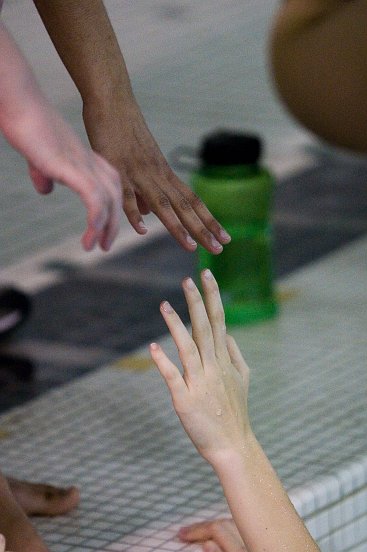
Chelsea water polo players prepare to conclude a timeout during their game against Grand Blanc. After seeing their coach ejected in the third quarter, the Bulldogs faced the task of playing the fourth quarter without a coach; however, due to an injury late in the third, Grand Blanc elected to forfeit.
If you’re like me, you aren’t exactly thrilled when Erin, the pink-haired star of the odd Esurance commercials, invades your TV. I know I’m eagerly awaiting the day Erin and her barely-useful unnamed costar will be relegated to the TV Advertising Retirement Home, where they will stare off into space, let food dribble down their chins and, in their more lucid moments, join the Budweiser whassup guys in fondly remembering their glory days on the American airwaves.
(Official Mindreader accountant Buckley wonders about the target audience for those Esurance ads; he says they seem to be directed towards 12-year-old boys. And 12-year-old boys, of course, do not purchase car insurance. But that is a tangent.)
Within the stable of Erin Esurance commercials, there are sports-themed commercials for each of the four major sports: football, basketball, baseball and hockey. Since it’s playoff time and I’m watching plenty of sports, I am all too familiar with the Esurance sports commercials. Tonight was a Pistons playoff game, so I was inundated with Erin on the basketball court.
In the Esurance basketball commercial, Erin is struggling to defeat large (seriously, they must be 20 feet tall) robots who have the audacity not just to completely disrespect the small flying referee, but also to sport 1970s-style headbands, wristbands and facial hair while they’re at it. With only a few seconds left in the game, Erin’s coach — the aforementioned barely-useful unnamed costar, who seems to have embraced the 1970s facial hair theme — draws up a magical game-ending play named “Quote, Buy, Print.” The ever-perky Erin struts onto the court, baffles the audacious robots with off-the-hook basketball moves and dunks the ball to win the game. (In a particuarly amusing moment, as she is flying towards the hoop, her ponytail holder pops off, thus freeing her hair to be glamorous. Apparently she could not truly win without being an animahottie.)
Thanks to the NCAA basketball tournament, I’ve seen that commercial far too many times; however, this time, something caught my eye. There seemed to be an extra element in the commercial: later in the commercial, as Erin is soaring through the air to confront the last remaining giant robot, I thought I spotted a familiar team logo on her uniform. But I wasn’t completely sure, so while I waited for the commercial to air again (truly, something I never thought I would actually want), I checked the commercial Esurance offers on its website:

And when the commercial aired again a few minutes later, I took a picture of that same part of the commercial (I apologize for the poor picture quality; photographing a TV is problematic anyway, and the station does not come in particularly clearly for us):
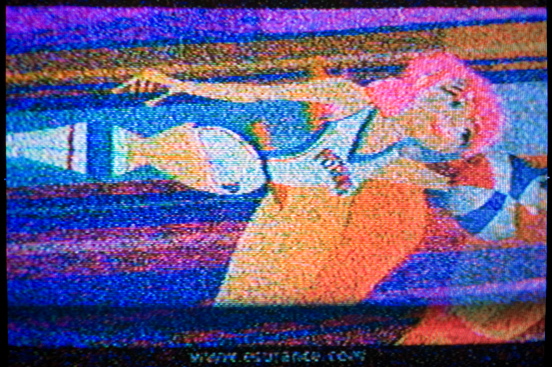
When I saw the second picture, my suspicions were confirmed: to localize the commercial for the Detroit area, not only did they change her blue, green and white Esurance uniform to a red, white and blue Pistons uniform, but they added the Pistons wordmark on her jersey. They even removed the Esurance logo on her shorts and added a Pistons P. And if they made that effort for Detroit, I presume other NBA markets received a similar treatment.
I still won’t shed a tear when Esurance ends this campaign, but really, that attention to detail is pretty cool. Especially because that detail really isn’t that noticeable (unless you’re strange like me). So, Esurance: well done.
And Erin Esurance: go away.
Digital images frustrate me.
I suppose it might seem odd for me, a photographer with two digital cameras, to make a statement like that; these days, I add several hundred new images a week to the Burrill Strong Photography website. So I should clarify: I’m frustrated not at my images, but at the monitors displaying my images.
The display of digital images is one of the unique complications of digital photography. Printed images are simple and consistent: you can show that picture to any number of people, and the print quality, colors and sharpness will not vary. The hundredth person will see the same picture the first person saw; there will be no unexpected changes.
Unfortunately, an image on the internet does not have the same assurance of consistency; depending on the monitor used to display an image, certain aspects of that image can vary — often slightly, but occasionally significantly. When an image is uploaded for viewing on the internet, the image’s creator is forced to accept this variance as a cost of easy distribution.
For snapshots, the monitor problem is scarcely relevant; the details of color accuracy and proper exposure are not high considerations in the realm of point and shoot memories. If the content is recognizable, the image is ready for distribution.
For those in the business of photography, it is not quite that simple. Since I am in that business, I’m not just tossing images around the internet to share memories; I’m producing images for which I expect customers to give me actual money, so I have to produce images that customers will see as being worth actual money. And that means paying attention to those details of color accuracy and proper exposure (among other things) so that the printed images I sell will be worth buying.
To aid my pursuit of images worth actual money, I made a point to purchase a monitor known to be good for photo work; when I process images using that monitor, I can be confident that the images I see on the monitor will not surprise me by being different when I print them. I know I don’t have to compensate for my monitor’s shortcomings, and that confidence makes my task easier.
The problem begins when I put my images online for public viewing. I know I can trust my monitor, but I also know that I can’t trust most of the monitors that will be displaying my images; higher-end monitors — like the Apple Cinema line — cost more than the average Best Buy offering, and most people don’t have a reason to spend that extra money on a monitor.
On one hand, I can’t say I blame the consumers who buy the $200 19″ LCD monitors. It’s an LCD, it’s 19 inches, and it’s $200; that is an attractive set of features in one place. And really, it would be impossible for me to convince those consumers to spend three times as much on a monitor they’ll be using only for basic web surfing and word processing. Normal everyday web surfing is hardly detail-critical work, and $200 is much more appealing than $600.
On the other hand, for me as a photographer who makes an effort to produce quality images, it’s frustrating to have to trust those images to the average — or worse — monitors used by those who view my work online. Those images will look good enough, but the quality that would be apparent on a good monitor or in print won’t show as it should on a cheap monitor.
By itself, that wouldn’t even be so bad. If I could count on the users of subpar monitors to judge images within the context of their monitors, the preponderance of those monitors wouldn’t be such a significant concern; in a perfect world, I could expect a general understanding that these monitors aren’t doing the images any favors.
But I can’t expect that sort of understanding from everyone, so I’m left knowing that some potential customers, after viewing my images on a low-quality monitor, might decide the images are not worth the money. And if their monitors’ shortcomings had an effect on their decisions, it’s frustrating for me because that’s something over which I have absolutely no control. I can make images that look good on quality monitors and in print, but I can’t make cheap monitors better.
Fortunately, I suspect there aren’t hordes of people who let their cheap monitors affect their decisions to a significant degree, so I don’t need to spend my days fretting about the business these monitors might cost me. But it is still in the back of my mind, so, as a photographer, let me make this request: either buy a good monitor or remember that you didn’t buy a good monitor — and remember that the images you see will look better in print than they do on that monitor.
(More reading: an explanation of the different types of LCD panels.)
The cleft of the tree (24 April 2007).

Across the road from my house, a dandelion found an interesting place to grow: a foot or two off the ground in a tree trunk. It seems like the arrangement would make a good metaphor.
“BERLIN (Reuters) – A pregnant cow being chased by police and fire fighters caused 25,000 euros ($33,900) of damage on a three-hour rampage through the German city of Hanover.”
I’m not even kidding. Hanover was terrorized for three hours by the Dairy Destroyer … the Bovine Bully … the Malevolent Moo.
I’m not even going to try a joke here; it’s humorous enough as it is.
Running on cloud nine (20 April 2007).
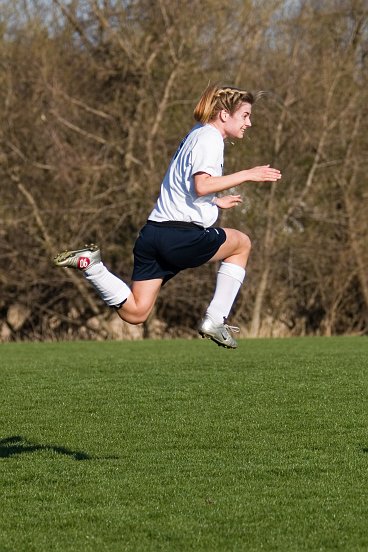
Here’s your chance. What should the caption be for this photo?
(I expect outstanding contributions from all of you, but here’s the basic information: the player pictured is Mackenzie Lake, and Chelsea beat Parma Western, 3-0. See the full gallery.)
The other night, I was (yet again) watching the NHL playoffs on CBC. There was a game I wanted to watch, but for some reason I can’t remember — either two games were on at the same time or they simply weren’t showing it in the east — I was unable to see it on our nearby CBC station; fortunately, CBC had been advertising the availability of live streaming game video on their site, so I thought I would keep an eye on the game through cbcsports.ca.
It was a great idea … until I tried to open the video. Instead of seeing a hockey game, I saw this:
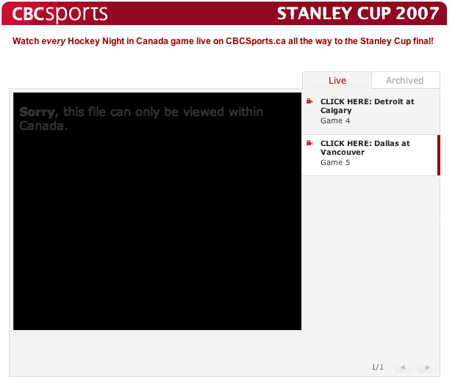
We have had a bit of a mystery here at the Stronghold. My chair sits in one corner of the house, and nearly every evening for several weeks, there has been an odd scratching noise in this corner. We knew it had to be an animal, but until recently, we didn’t know what sort of animal or where it was — in the attic, in the wall, or outside on the deck.
The other evening, I was watching that bastion of great white sport, Hockey Night In Canada. (The availability of CBC is one of the blessings of living so close to Windsor.) In the middle of the broadcast, the odd scratching occurred yet again, but this time something different happened: the TV picture very briefly dropped out and returned. As I was hoping the picture would hold, I remembered that the antenna cable runs up the outside corner of the house, exactly where the scratching was occurring; thanks to that brief technical difficulty, it became clear the animal was outside the house.
When I came to that realization, I took a look out the bay window to see if I could spot the animal. And this time, I finally managed to see the source of the scratching: an apparently mischievous and obviously pudgy raccoon.
A few days later, the raccoon visited when it was light enough to get a picture, so I put my camera up to the (appropriately named) picture window and photographed the culprit.
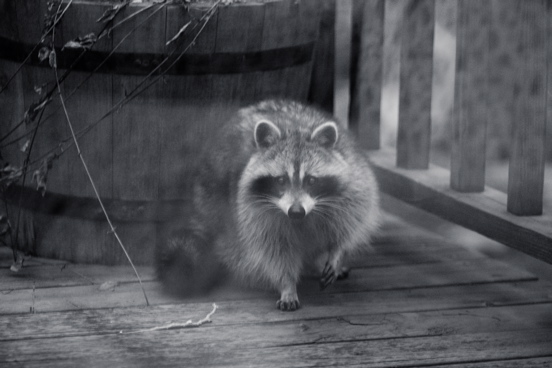
We have no idea why this particular raccoon is so fond of that one particular spot on the house, but there must be something either intriguing or infuriating to him; he’s spent weeks scratching at the same corner. But we have no plans to engage him in conversation to learn his motivation.
When I visited facebook tonight, my homepage contained an interesting contrast. I removed the names to highlight the contrast rather than the people.

The first is a gallery of pictures from a day at the firing range (the title is meant humorously); the second is a group calling for the banning of firearms in the U.S. as a response to the Virginia Tech shootings. (The group has a number of British members.)